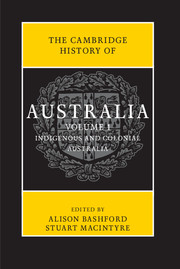Book contents
- Frontmatter
- Contents
- Abbreviations
- List of maps
- List of figures
- List of tables
- Notes on contributors
- Map
- Preface
- Introduction
- PART I
- 1 The past 50,000 years: an archaeological view
- 2 Newcomers, c. 1600–1800
- 3 Convict transportation in global context, c. 1700–88
- 4 The early colonial presence, 1788–1822
- 5 Expansion, 1820–50
- 6 The advent of self-government, 1840s–90
- 7 The gold rushes of the 1850s
- 8 Colonial states and civil society, 1860–90
- 9 Rethinking the 1890s
- 10 Making the federal Commonwealth, 1890–1901
- PART II
- Further reading
- Chronology
- Index
- Frontmatter
- Contents
- Abbreviations
- List of maps
- List of figures
- List of tables
- Notes on contributors
- Map
- Preface
- Introduction
- PART I
- PART II
- Further reading
- Chronology
- Index
7 - The gold rushes of the 1850s
from PART I
Published online by Cambridge University Press: 05 November 2013
- Frontmatter
- Contents
- Abbreviations
- List of maps
- List of figures
- List of tables
- Notes on contributors
- Map
- Preface
- Introduction
- PART I
- 1 The past 50,000 years: an archaeological view
- 2 Newcomers, c. 1600–1800
- 3 Convict transportation in global context, c. 1700–88
- 4 The early colonial presence, 1788–1822
- 5 Expansion, 1820–50
- 6 The advent of self-government, 1840s–90
- 7 The gold rushes of the 1850s
- 8 Colonial states and civil society, 1860–90
- 9 Rethinking the 1890s
- 10 Making the federal Commonwealth, 1890–1901
- PART II
- Further reading
- Chronology
- Index
- Frontmatter
- Contents
- Abbreviations
- List of maps
- List of figures
- List of tables
- Notes on contributors
- Map
- Preface
- Introduction
- PART I
- PART II
- Further reading
- Chronology
- Index
Summary
The 1850s gold rushes in eastern Australia occurred in a post-invasion landscape. Aboriginal people had so recently been in possession of the lands on which gold was discovered that contemporaries quite naturally compared the new invaders' mode of living to that of the Indigenous inhabitants. A reporter sent to Australia's first significant gold rush at Ophir in New South Wales in 1851 noted that ‘the whole settlement has the appearance of a vast aboriginal camp’. An observer of the Ballarat diggings in Victoria in 1856 wrote that ‘a solitary tree here and there, and prostrate trunks lying about, proclaimed the recent nature of the invasion of the haunts of the wildman by the gold-seekers’. The gold rushes were, among other things, an extraordinarily effective invasion: it is difficult to think of anything else that would have populated the newly taken land so rapidly, with such numbers, so heedless of what lay in their way.
Discoveries and rushes
It was Edward Hargraves, returning in January 1851 from the California gold rush to New South Wales, who most single-mindedly tried to provoke a gold rush in Australia. With a small group of men he found gold in a creek near Bathurst in February 1851. Leaving the others to dig, Hargraves returned to Sydney; by April his party had four ounces of gold. He notified the New South Wales government of his find, and gave the Sydney Morning Herald the story. Soon newspapers were reporting the effects of the news: a Herald correspondent found the ‘gold mania’ in Bathurst ‘still more violent than in Sydney’ and speculated that there must be gold in ‘unlimited quantities, if such gold fields are scattered over such an extent of country as is reported’.
Hargraves was feted and rewarded as first discoverer of gold, but his real achievement was in publicity.
- Type
- Chapter
- Information
- The Cambridge History of Australia , pp. 170 - 188Publisher: Cambridge University PressPrint publication year: 2013
- 3
- Cited by



